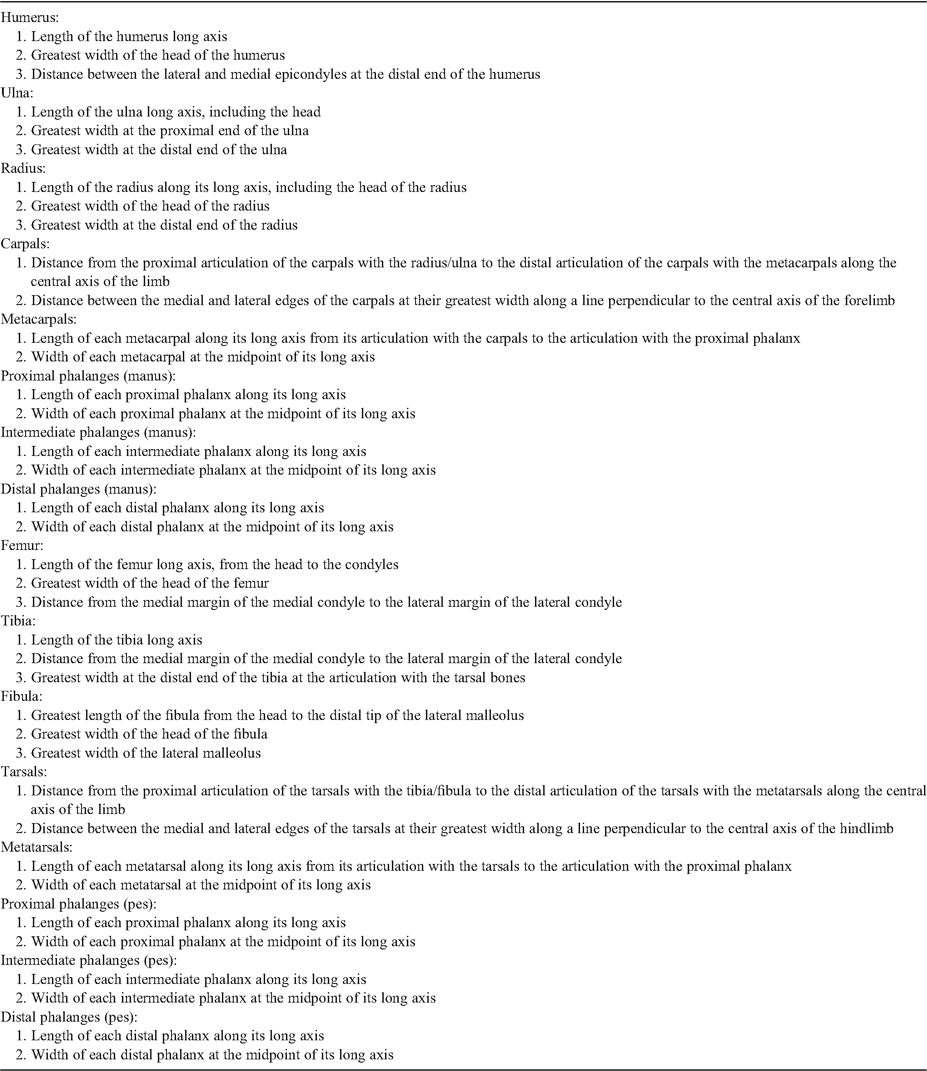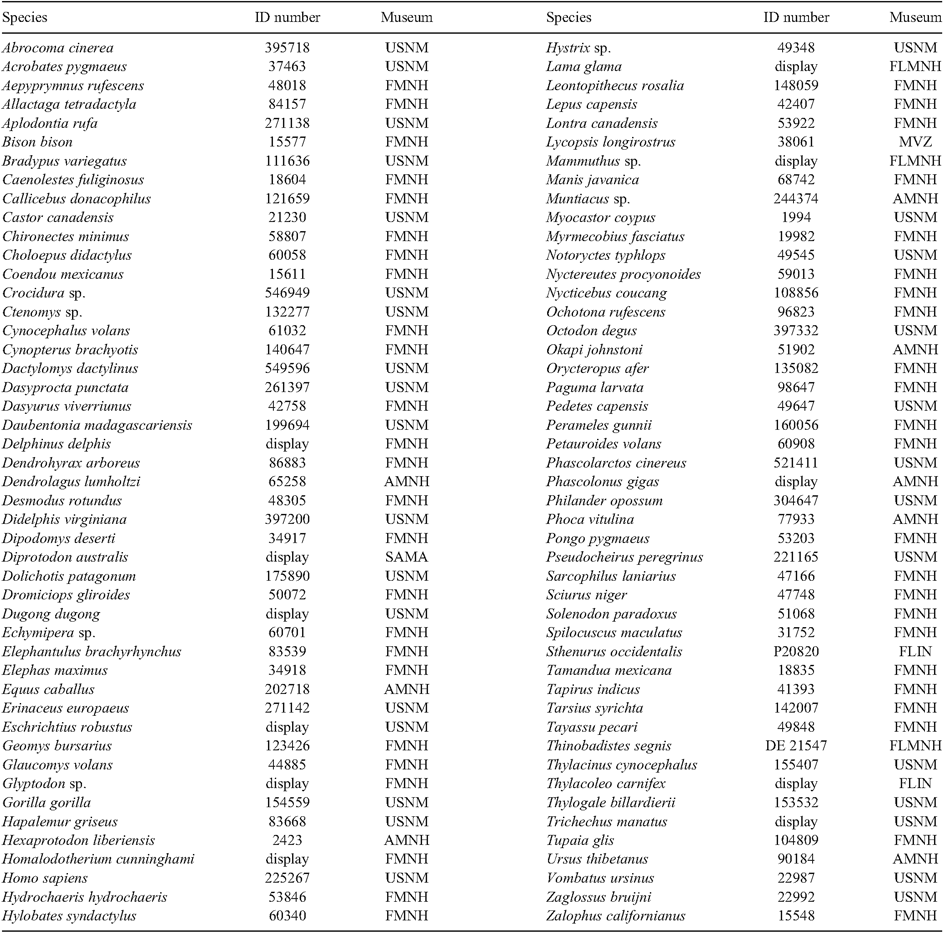Developmental constraint on the evolution of marsupial forelimb morphology
W. James Cooper A B C and Scott J. Steppan AA Department of Biological Science, The Florida State University, Tallahassee, FL 32306-4295, USA.
B Present address: Department of Biology, Syracuse University, 107 College Place, Life Sciences Complex, Syracuse, NY 13244, USA.
C Corresponding author. Email: wjcooper@syr.edu
Australian Journal of Zoology 58(1) 1-15 https://doi.org/10.1071/ZO09102
Submitted: 7 October 2009 Accepted: 19 January 2010 Published: 7 April 2010
Abstract
Compared with the placental mammals, marsupials are born at an almost embryonic stage, but nearly all of these neonates immediately climb or crawl to one of their mother’s teats using precociously developed forelimbs. Marsupial adults also exhibit limited forelimb shape diversity relative to the members of their sister group. That the functional requirements of this natal climb have imposed a developmental constraint on marsupial forelimb evolution represents a compelling and widely accepted hypothesis, yet its resulting predictions for the comparative patterns of mammal limb shape diversity have never been tested. In order to perform such tests we conducted extensive taxonomic sampling of mammal limb morphology (including fossil specimens), and then examined these data using morphometric methods, non-parametric analyses of anatomical disparity, and phylogenetic comparative analyses of evolutionary rates. Our results strongly support the constraint hypothesis, and indicate that the highly significant differences between marsupial and placental forelimb shape diversity has been strongly influenced by different rates of morphological evolution among the distal forelimb elements in these two important mammal lineages.
Additional keywords: comparative method, developmental constraint, eutheria, forelimb, hindlimb, marsupial, metatheria, morphological evolution, morphometrics, placental mammal.
Acknowledgements
We thank Mike LaBarbera, Bill Parker, William Herrnkind, Mark Westneat, Barry Chernoff, Miriam Zelditch, Don Swiderski, Brian O’Meara, Craig Albertson and Geeta Sawh for valuable support and assistance. We also thank the staff of the following museums and universities for access to specimens: AMNH, FLIN, FLMNH, FMNH, MVZ, SAMA, and USNM. This work was supported by a grant from Sigma Xi and by the Department of Biological Science at The Florida State University.
Alroy, J. (1999). The fossil record of North American mammals: evidence for a Paleocene evolutionary radiation. Systematic Biology 48, 107–118.
| Crossref | GoogleScholarGoogle Scholar |
Burnaby, T. P. (1966). Growth-invariant discriminant functions and generalized distances. Biometrics 22, 96–110.
| Crossref | GoogleScholarGoogle Scholar |
Jansa, S. A. , and Voss, R. (2005). Phylogenetic relationships of the marsupial genus Hyladelphys based on nuclear gene sequences and morphology. Journal of Mammalogy 86, 853–865.
| Crossref | GoogleScholarGoogle Scholar |
Jeffery, J. E. , Richardson, M. K. , Coates, M. I. , and Bininda-Emonds, O. R. P. (2002). Analyzing developmental sequences within a phylogenetic framework. Systematic Biology 51, 478–491.
| Crossref | GoogleScholarGoogle Scholar |
Lentle, R. G. , Kruger, M. C. , Mellor, D. J. , Birtles, M. , and Moughan, P. J. (2006). Limb development in pouch young of the brushtail possum (Trichosurus vulpecula) and tammar wallaby (Macropus eugenii). Journal of Zoology 270, 122–131.
Marshall, L. G. (1974). Why kangaroos hop. Nature 248, 174–176.
| Crossref | GoogleScholarGoogle Scholar |
O’Meara, B. C. , Ane, C. , Sanderson, M. J. , and Wainwright, P. C. (2006). Testing for different rates of continuous trait evolution using likelihood. Evolution 60, 922–933.
Pujos, F. , and De Iuliis, G. (2007). Late oligocene Megatherioidea fauna (Mammalia: Xenarthra) from Salla-Luribay (Bolivia): new data on basal sloth radiation and Cingulata–Tardigrada split. Journal of Vertebrate Paleontology 27, 132–144.
| Crossref | GoogleScholarGoogle Scholar |
Reyes, A. , Gissi, C. , Catzeflis, F. , Nevo, E. , Pesole, G. , and Saccone, C. (2004). Congruent mammalian trees from mitochondrial and nuclear genes using Bayesian methods. Molecular Biology and Evolution 21, 397–403.
| Crossref | GoogleScholarGoogle Scholar |
Sanchez-Villagra, M. R. , and Maier, W. (2003). Ontogenesis of the scapula in marsupial mammals, with special emphasis on perinatal stages of Didelphis and remarks on the origin of the scapula. Journal of Morphology 258, 115–129.
| Crossref | GoogleScholarGoogle Scholar |
Waddell, P. J. , and Shelley, S. (2003). Evaluating placental inter-ordinal phylogenies with novel sequences including RAG1, gamma-fibrinogen, ND6, and mt-tRNA, plus MCMC-driven nucleotide, amino acid, and codon models. Molecular Phylogenetics and Evolution 28, 197–224.
| Crossref | GoogleScholarGoogle Scholar |
Windsor, D. E. , and Dagg, A. L. (1971). The gaits of the Macropodidae (Marsupialia). Journal of Zoology 163, 165–175.

Withers, P. C. , Thompson, G. G. , and Seymour, R. S. (2000). Metabolic physiology of the north-western marsupial mole, Notoryctes caurinus (Marsupialia: Notoryctidae). Australian Journal of Zoology 48, 241–258.
| Crossref | GoogleScholarGoogle Scholar |

Wroe, S. , and Milne, N. (2007). Convergence and remarkably consistent constraint in the evolution of carnivore skull shape. Evolution 61, 1251–1260.
| Crossref | GoogleScholarGoogle Scholar |

Yu, L. , and Zhang, Y. P. (2006). Phylogeny of the caniform Carnivora: evidence from multiple genes. Genetica 127, 65–79.
| Crossref | GoogleScholarGoogle Scholar |

Zelditch, M. L. , Fink, W. L. , Swiderski, D. L. , and Lundrigan, B. L. (1998). On applications of geometric morphometrics to studies of ontogeny and phylogeny: a reply to Rohlf. Systematic Biology 47, 159–167.
| Crossref | GoogleScholarGoogle Scholar |


|

|



